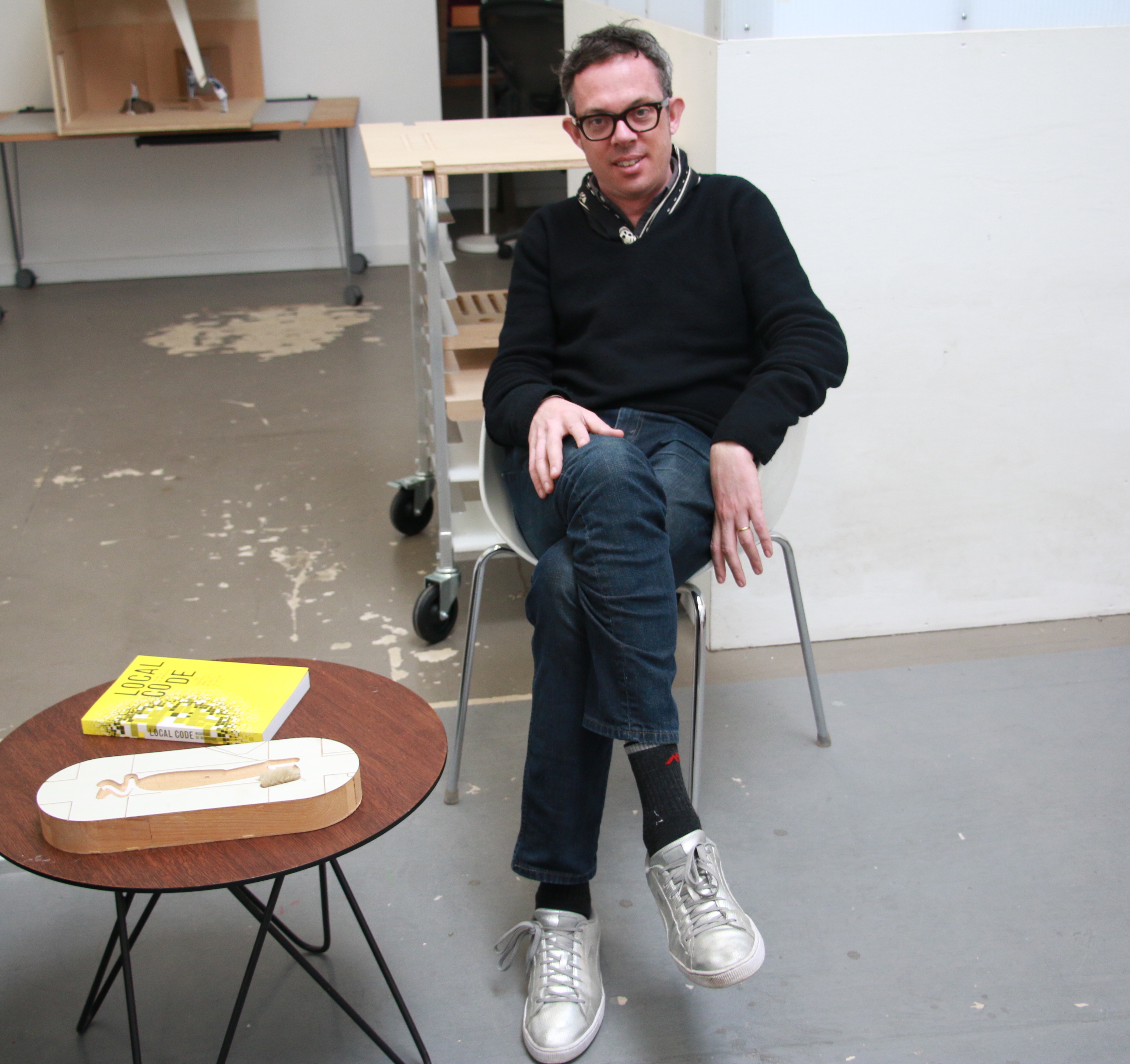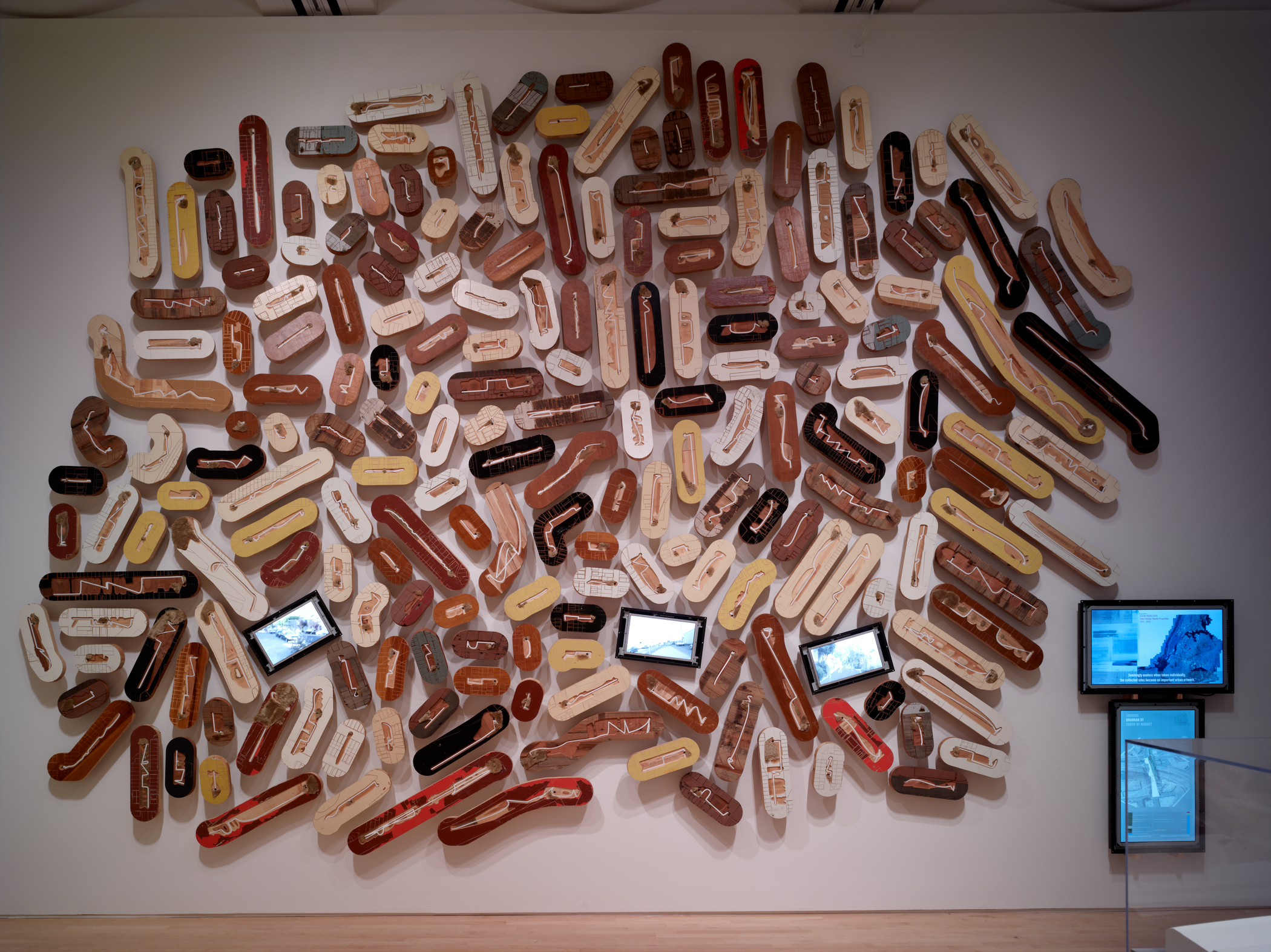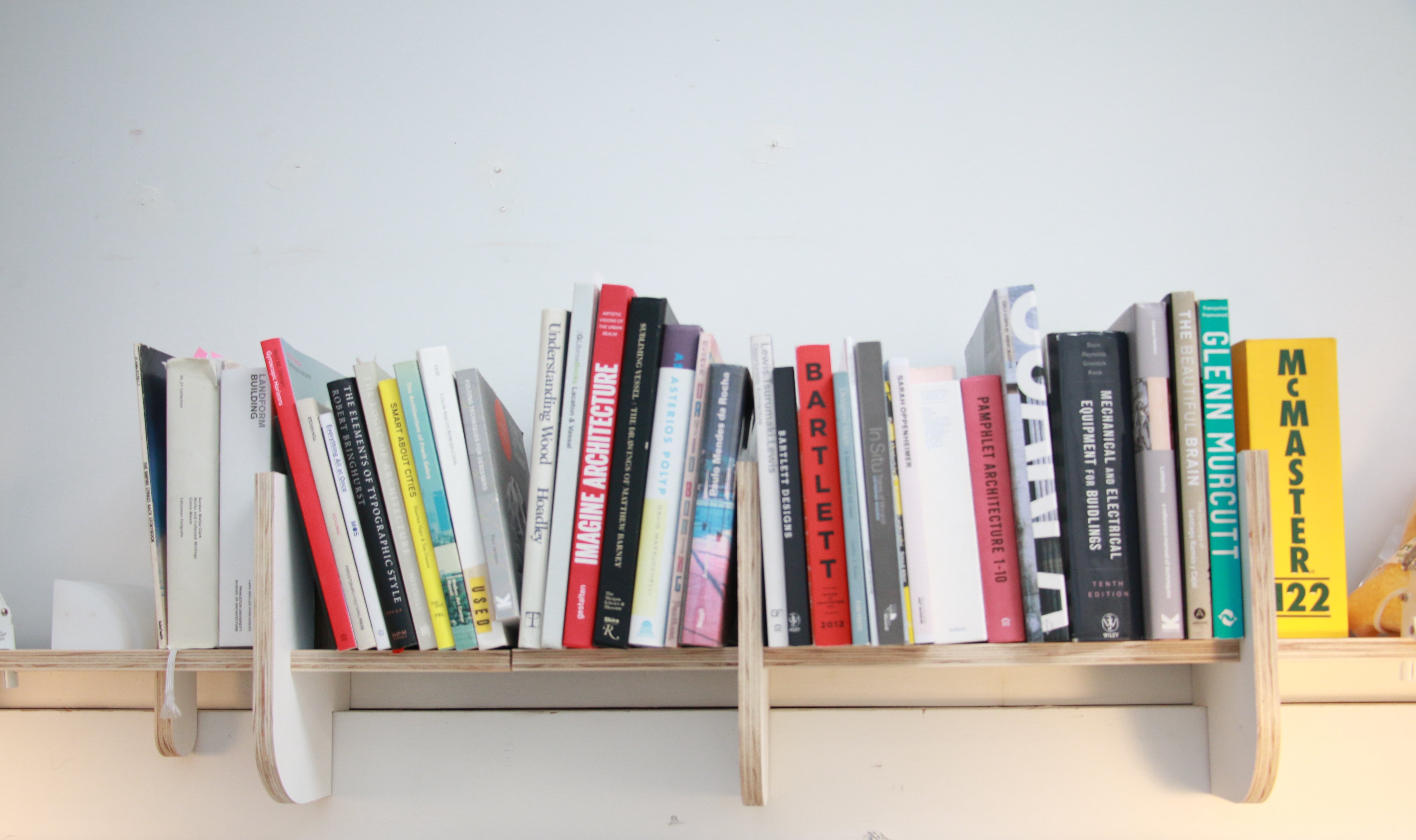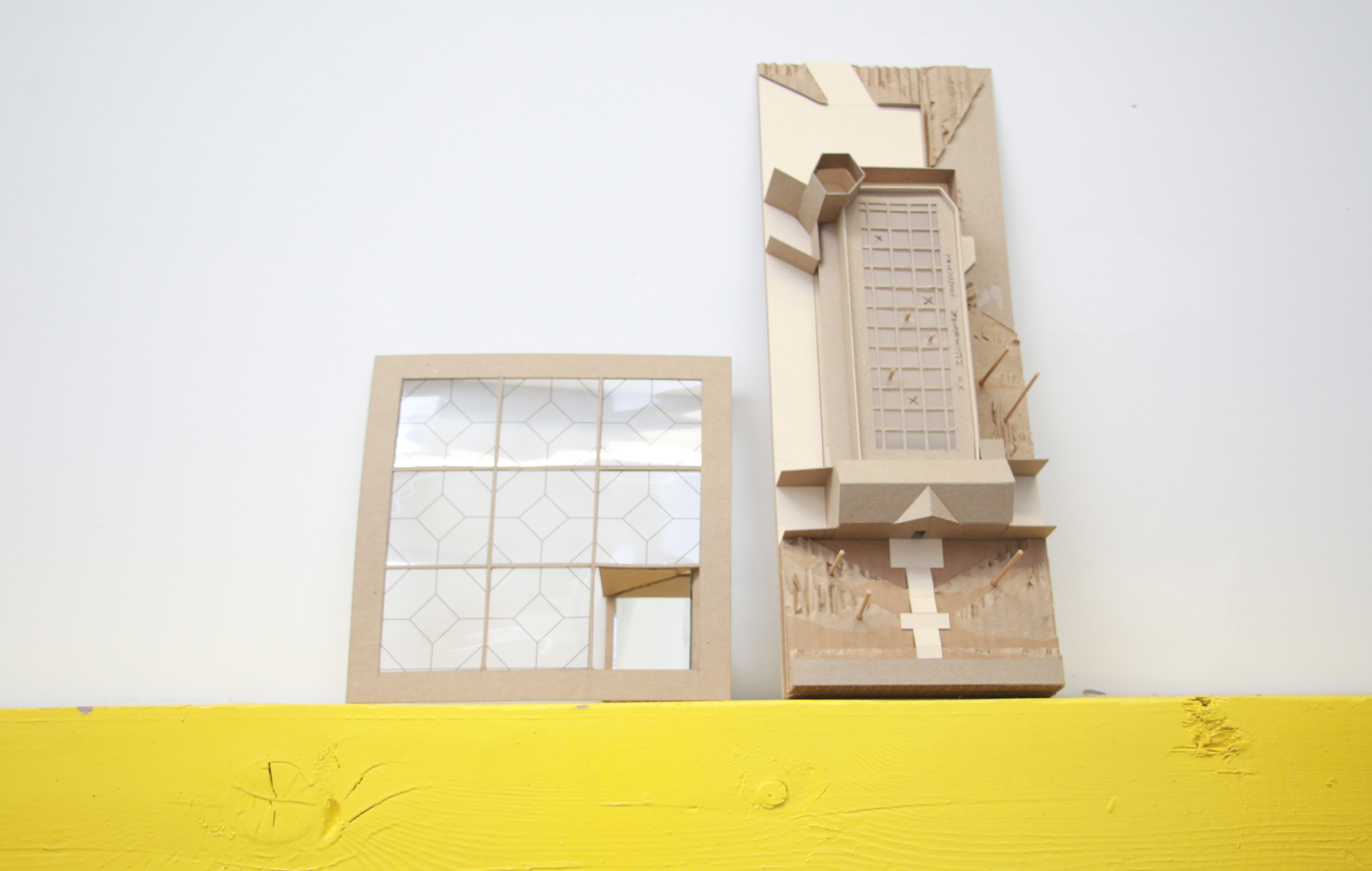In a bright, open studio in Oakland, Nicholas de Monchaux works with his partner, Kathryn Moll. Together they make up Modem, an architectural practice that works to collapse the separations of environment and structures often found in traditional architectural designs. De Monchaux is a professor of architecture and urban design at the University of California, Berkeley; the director of the Berkeley Center for New Media; and a frequent collaborator with Public Knowledge. In his studio, de Monchaux talked about the intersections between public spaces, technology, and the environment, and considered the changing role of museums in contemporary society.

Nicholas de Monchaux at his studio in Oakland.
SOPHIA FISH: What kind of projects do you produce through Modem?
NICHOLAS DE MONCHAUX: We do work that operates at two very different scales. In 2017-2018, we were a partner in a team in something called> Resilient by Design Bay Area challenge, which was a large competition funded by the Rockefeller Foundation to think about resilience in the Bay Area. It is modeled after a design competition that was held in New York City after Hurricane Sandy, in which teams of architects looked to how New York could become more resilient to things like storms, the frequency and intensity of which are of course increasing with climate change and sea level rise.
SF: What are the outcomes of the challenge?
NDM: New York City had money to build the projects. Here in the Bay Area, especially because the disaster hasn’t happened yet—whether it’s storms and sea level rise or earthquake, it’s likely to—there are no funds for construction. There’s a lot of money for research and visualization and making proposals on different sites, and our team is working on the San Leandro Bay, which is the body of water that connects Alameda and the Oakland Airport and the Oakland-Alameda County Coliseum. My own work on resilience is connected to the project that I did that was shown at SFMOMA in 2012, Local Code, which looks at how the superabundance of information that we’re starting to get about cities can help us make cities more resilient—not just ecologically but also socially and economically.
SF: Describe your Local Code project.
NDM: Local Code was actually inspired by Gordon Matta-Clark’s Fake Estates project, where he collected deeds and documentation to small vacant lots in New York City. He intended to work further with what were eleven small vacant lots, but died before he could make sense of them or figure out what to do with them. Starting in 1992, the deeds and photographs were shown as artworks in their own right.
What I was interested in was the fact that, with modern information systems, we could find many thousands of these sites and then start to figure out what to do with them. I looked with my students at Berkeley at these 1,500 sites in San Francisco. These sites together almost serve as a map of neighborhoods of poverty or respiratory ailments or cancer diagnoses, because poor people live in neighborhoods with vacant lots and don’t have access to public health. If you also look at environmental factors like the urban heat island or the lack of ground cover or the presence of problems in the stormwater system, that’s where the vacant lots are. So the proposal imagines taking all the funds that we spend on environmental upgrading, and spending them instead on lots and lots of little interventions throughout the city. That would do all this ecological and infrastructural work for the city, but then also put things that look like parks into all these neighborhood that don’t have them.
Local Code is a very representative project of our work, because it’s both connected to art history and has a life in the gallery, but it’s also about public space and social policy. It’s representative of the way in which architectural practice is a kind of social practice, in that the work obviously has a life and culture. This is being presented at biennials and triennials and galleries, but also has a life in the world of policy. It was exhibited at SFMOMA in 2012, but in the same year it was also exhibited across the street at SPUR. What was so interesting to me was that it had a very different life in both of those contexts, where the conversations were very different.

Installation view of Local Code at SFMOMA, part of The Utopian Impulse: Buckminster Fuller and the Bay Area, 2012. Courtesy of SFMOMA.
SF: What is the time frame for a project like this?
NDM:
This was massive—it was a ten-year project. It started in 2009, and then the book came out in 2016. And it’s still ongoing; we’re still working, especially in New York, because these sorts of distributed investments in equity are a big part of what the [Mayor Bill] De Blasio administration is wanting to do in its second term. So we’re doing some studies on how we could both inform how to make the city more sustainable but also provide job training for the community in which these interventions could potentially go.
That’s very connected to this larger context of resilience in thinking about climate change in particular as a social and cultural phenomenon, as well as a physical and ecological phenomenon, which is a big part of Kate’s and my practice. In the most fundamental way, our practice is based on the understanding that, especially at this point in human history, both nature and technology are as much social and cultural artifacts. We’re inside of them, not outside of them, as practitioners.
SF: At Public Knowledge’s The Limits of Free Speech event, you discussed how technology alters public discourse. How does this relate to your practice?
NDM: To have a conversation about free speech in 2018 and not have the headline be the transforming and distorting powers of contemporary technological speech is to entirely miss the point. Even at Berkeley, when we had the conversation about free speech in the fall and around the Milo Yiannopoulos visits, it was so exasperating to see the community divided not by its values but by its understanding of the effects of technology on speech, but thinking that it was divided by its values. You had a group of people who are less familiar with how speech works on social media platforms saying that we need to protect freedom of expression at all costs, and a group of younger people saying the way that freedom of expression is working is not working—and they were both right.
It’s precisely not that we needed to listen to one side over another, we needed to help the people who didn’t understand the effects of technologies on speech to understand how that had altered the landscape. With this notion of attention being the commodity—not information—in order to preserve the same set of values, we need to radically rethink what we’re doing, not to alter or support freedom of expression in public society, but precisely in order to maintain the same level of public discourse.
That’s an example of how something like technology is a cultural artifact with deep impacts on culture, and it relates also to climate change in the way that to understand the geopolitical complexities of the contemporary world in the absence of climate change is to completely miss the point. It’s the reason why there are problems in Syria, why there are conflicts in Yemen—it’s not because these places are ungovernable, it’s because they are ecologically collapsing.
SF: Talk about the Berkeley Center for New Media. What is “new media”?
NDM: Media is anything through which we see the world, experience it. Media comes from the Latin word for lens, so it’s something that both enables a new way of seeing or making—like looking through a magnifying glass—but also distorts that way of seeing. At the Berkeley Center for New Media, we are a radically interdisciplinary campus center bringing together people from fields as diverse as art, robotics, information design, and engineering who are interested in looking at an understanding of two things: prospectively, the profound effects that new media today are having on our ways of thinking and practice—from big data, to CRISPR, to artificial intelligence—and then also these contemporary transformations, looking back to history to see the particular effects of media when they were new.
In each of our disciplines, the effects of new media are so profound that we learn as much or more by talking to others who are having similar experiences in their own disciplines than we do by looking to the specific histories of our own. It’s a very pragmatic, collective conversation about the fact that all of our disciplines are getting messed up and upended. This is what excites me so much about the Public Knowledge program: it represents a very sincere and successful attempt by SFMOMA to grapple with the parallel effects of these same bracing transformations we’re talking about in the context of free speech on the museum itself and on the role of curation in public life.

Books on art, design, and technology line the shelves at Modem.
SF: How do you see the role of museums in this evolving landscape of technology?
NDM: Art museums were originally designed to civilize the new middle class and to induct them into proper ways of thinking and looking at the world. Curating was to select for an uneducated audience the things that were important and the things to which they didn’t previously have access. The commodity was the art, and the curation was to obtain and select these valuable pieces of matter and drop people in front of them. Now, of course, in the way that parallels the larger conversation on free speech, the commodity at the museums these days is not objects, but attention, so curation is very precisely not the shaping of collections of objects to which people will expose themselves, it’s the attempts to try to grab and hold and shape the attention of the public, which is why so many museums are having problems.
Nowadays I think we have the opportunity to combine and invert that logic to the public to help us understand what’s important. We don’t have a one-way transmission of culture anymore, but that’s actually quite exciting. So something like the Public Knowledge program would have, twenty years ago, been considered part of the museum’s outreach efforts, whereas now it’s actually part of the content of what the museum is doing, which I think is a great shift.
Now everyone’s a curator, everyone has a feed. The traditional role of museums as the arbiters of taste has gone. Just like the traditional role of the few newspapers as the arbiters of truth has gone. For museums particularly, it’s potentially a moment not of limitations but of liberation. Especially in an increasingly mediated world, the role of museum as a social condenser and a physical place for conversation and encounter with ideas that might help you get out of your own bubble is potentially essential, not just to the future museums but to the future of our culture as a whole.
SF: I’m thinking, then, of the question of accessibility. People talk about museums as being these hubs of important, modern ideas about cities and public space, and yet there’s a contradiction in that they’re often not accessible to a greater public.
NDM: There are two questions there. One is, who is going to museums? And I think this is a profoundly important place to work. The museums themselves are public institutions. Our public institutions, especially in this country, more broadly are abdicating their public role. Companies don’t think of themselves as serving the public interest. Museums do, they are nonprofits. They have nonprofit status, they serve the public interest. I think museums need to get more serious and creative about how to serve that public interest while remaining solvent. But one area of particular concern is who is going and why, so that needs to be addressed.
The other question is, how do museums continue to remain solvent and remain public? Some of the best parts of the new SFMOMA, like the [Richard] Serra piece [Sequence, on view in the Roberts Family Gallery], are moments where the museum has drawn the private part of itself inward and given more back to the city in terms of the public space. And I think that the physical space of the Public Knowledge Library is a great example of something that is adaptive, and in between public space and private space. And those kinds of in-between spaces are what museums need to provide more of, like ideally the sidewalk comes all the way up to the third or fourth floor.
SF: Why did you choose to write your book Spacesuit: Fashioning Apollo? Why the Apollo spacesuit, and how is it related to architecture?
NDM: That book began as a paper I did in grad school in a seminar on domestic space. I tried to think of the most extreme domestic space that I could think of and thought of the spacesuit. I ended up discovering that it was designed not by a military-industrial contractor but by the Playtex bra and girdle company, and made not by heroic male engineers but by female seamstresses. The book became, therefore, a way of storytelling about design and technology in the contemporary age. I wanted to show, through a kind of historical example, how a certain very systematic mode of engineering design that built the rest of the space program was, in fact, incapable of designing for the complexities of the human body. Instead, the interface between the human body and the larger system of Apollo had to be designed very differently, much more adaptively, using techniques of fashioning. Fashioning, you know, is a word that means “of the moment,” but it also means “adaptation.” What I ended up also discovering and doing a lot of original research about is a kind of system of analogy to designing for cities.
So much of the designing for outer space or designing for a search engine or designing for our contemporary technologies is about the problem of optimization—how to make something optimize—but bodies are not problems of optimization, and cities are not problems of optimization. Yet when we’re designing ever more with technological tools, our tools tend to want to make us treat designing for cities and bodies as problems of optimization, when they’re just not—our bodies are much more ridiculous and weirder than that, and same with cities.

De Monchaux and his students at UC Berkeley make models to experiment with adaptive architectural designs.
SF: What kinds of projects do you work on with your students?
NDM: For the past few years I’ve been teaching around issues of urban design and climate change, and on how what gets called architectural representation—basically architectural drawing and model making—needs itself to change, to adapt to this new future. Unlike, say, the temporary installations in galleries, or set designs, most architecture is rhetorically permanent and fixed—think about the gravestone, or the monument, or the pyramid. It’s like giving to a piece of architecture the permanence that we don’t have in our own existence.
Architecture usually is done for self-aggrandizement and the decoration of institutional permanence. Whereas designing and adapting to climate change means making things that are temporary and adaptive, and that can suit circumstances that we can’t necessarily foresee. So the work has to be much more open-ended and contingent and humble about its own longevity.